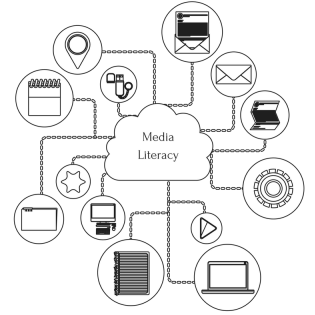Media Literacy
Media Literacy
With all of the ways we get media, it is difficult to sort out what information we are absorbing and what is real. Sifting through all of the information can be difficult for even the most adept media consumer. Learning to Give offers this Media Literacy guide to help young people block noise and use intuition, logic, and research to analyze information sources. Before taking action, make sure you have the facts right.
To promote constructive and robust discussions about current topics, use Learning to Give's resource guide to Critical Conversations.
First, Be a Skeptic
Media is designed to catch and hold your attention. On social media, new information is constantly scrolling in front of you, and it is easy to absorb a lot of information without stopping to ask yourself, "What do they want me to do or think? Is this credible? Is it reinforcing a bias?" Just because a story or image goes viral, it doesn't mean it is true or accurate. Over time, we build up stories in our subconscious, and not all of them are true. The first rule of media literacy is to be skeptical.
Be Skeptical: This means, stop and ask whether this feels true. Use your intuition. If it seems at all questionable, go to a source you trust and verify it.
- For example, a viral post reports a shocking story about people from a marginalized group harming children. This is aimed at catching your emotions and overriding your logic. Before believing, sharing, or acting on the story, make sure it is true. We provide some ideas below.
- If you see your friends spreading this hateful information, send them a private note saying, "Check your source; I'm pretty sure this is not accurate."
A healthy skepticism helps stop misinformation from spreading or becoming part of our subconscious.
What to Watch For
Even with the best intentions to make a change in the world, we can be misinformed if we aren't careful. Look out for the following techniques used to persuade.
- If it strikes your emotions, it is worth a second look. Emotions can be the prompts that move us to action, but they are also the tools to move you from thinking logically.
- Stories that seem shocking, dramatic, or too good to be true are ones to question. They are also the ones that raise our justice radar. Just make sure they are real stories.
- Media attacking a person's character, misrepresenting an idea, or using a single anecdote as evidence are meant to distract from the truth.
- Flashy and polished can be very attractive, but this can also distract you from facts.
- Pay attention to who wrote the article or media piece. Is it a credible source, a respected source of information? What are their sources?
- Does the piece have a point of view that reinforces a bias? Think about how someone else might see this. What values or POVs are represented or omitted in this message? Confirmation bias is when you seek out information that affirms your perspective. Are you welcoming information from well-rounded points of view?
Verify Facts and Credibility
If your intuition prods you to look further, here are some things you can do.
- Go to another site and look up the information. Be critical of claims made by influencers. Can you find the same information somewhere else? Check the reviews on the site that is making a claim.
- Read more about the issue or claim on a site that checks for credibility and bias, like PolitiFact.
- Go to the library to read more about an issue you care about.
- The News Literacy Project helps people be smart, active consumers of news and information and engaged participants in a democracy. See their survey results about people's ability to separate fact from fiction in media.
- Look up and review the source of information:
- Do you recognize the source and is there an author byline?
- Is the content backed up by research? Does the research come from a reputable source?
- Is it reportage or opinion? Inflammatory language is probably opinion; if written in the first person, it is seldom reportage.
- If the heading entices you to open, is it merely "clickbait"?
- Is it a primary or secondary source? Primary sources are generally more credible. For help with identifying primary and secondary sources and a chart illustrating the uses of each, Indiana University provides a nice overview resource.
Take Action with Integrity
Now that you have some knowledge about media literacy, you can take social action to make a difference using facts and integrity.
- Use only facts from reputable sources to communicate the need and solution.
- Persuade others to join you with facts, not emotion.
- Use curiosity and vulnerability to be open to other perspectives. Avoid using divisive language or echo chambers, which reinforce one point of view and shut out alternative ideas.
- Invite conversation to find solutions together.
